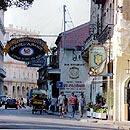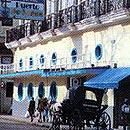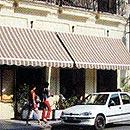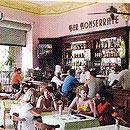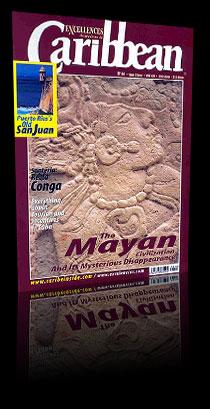Monserrate Street, Two times in just one space
Built inside the walls that once kept the city locked in for centuries, this street is still cobbled on the same spot where it was originally paved, in one of Havana's premiere locations of social and cultural growth.
Its name stems from the Hermitage of Monserrate, a sanctuary built in 1695 by the Catalonians who arrived in Cuba at the time. The surrounding vacant lots were used to build the Monserrate Square and it was eventually named after the wall gateway across from Obispo and O'Reilly streets.
With the beginning of the walls knockdown in 1863, pushed by the fast-paced growth of the outside part of town, Monserrate Street turned out to be one of the major communication avenues of the time since it used to connect the old part of the city with its growing suburbs in the outskirts.
Both a transit and transition route between Old Havana and the New Havana, the street was penciled in by a writer of the Republican Era as “the jugular artery in the heart of Havana.”
In this time of great splendor and finesse, some major buildings, like the majestic Palace of the Villalba Marquis (1879) and the Cuban-style neoclassical Aldama Palace, saw the light of day.
This used to be the place of choice for businesspeople, merchants, carriage drivers, management and financial employees, as well as the neighbors of the surrounding boroughs. Hardworking people from all walks of life and trades used to spend their leisure hours in Monserrate Street. Locals, slaves, freedmen and visitors from other provinces and nationalities strolled up and down this street in a city that was bludgeoning for all the world to see.
Religious celebrations, processions and festivities linked to the Hermitage of Monserrate, alongside the Negroes' own town hall with their dancing and singing disguised in ribbons and clanking bells, chipped in their own special Cuban gaudiness to the noisy neighborhood by the wall.
An array of eateries decked out with huge traditional Monserrate-built earthenware pots sprouted up all along the street to quench passers-by's thirst and spruce up an ambience that had been born out of the best Cuban and Spanish fusion. Traditional Catalonian dishes were commonplace in the neighbors' daily meals or during the Mayflower Festivals. Traditions and customs from two different communities melted into one another and managed to beat the passage of time.
Today, those same eateries, whose origins hark back to the birth of our city, have evolved into a compound of fancy restaurants with top-rated service, great food and superb drinks that serve both local and foreign patrons the very best of today's cuisine. La Zaragozana, El Castillo de Farnes, the Monserrate Bar, Hanoi, El Puerto de Sagua and El Baturro are part of a social restoration project aimed at ratcheting up the neighbors' living conditions. These places stand for the historic continuation that links two times in just one space: Monserrate Street.
La Zaragozana Opened in 1830 under the name of The Wall Eatery, it was built next to the Church of the Saint Guarding Angel and close to one of the wall gateways. Its current moniker came in 1930 in an effort to name it after its owner's hometown. Specialized in shellfish, Spanish food and international cuisine, this restaurants has been visited by some of world's top celebrities from the arts and sports, as well as by famed writers and businessmen.
El Castillo de Farnes This is corner of Catalonian invocation. Alongside La Zaragozana, they are the best eateries in town. Its name stems from the former fortress of Santa Coloma de Farnes that once stood on the premises. The restaurant's location used to be a food warehouse and a grocery store under the name of La Campana de Gracia. Besides serving exquisite Spanish food, its bar excels in cocktail making and the specialty of the house: the Farnes bull sandwich.
Monserrate Bar Former place in Havana –brought back to life in 1994- that has managed to keep patrons flocking in to date. This is the right spot to come and hear Cuba's traditional music. Such top musicians as Benny More, Bola de Nieve, the Matamoros Trio, Los Compadres Duet and Joseito Fernandez are praised in this place specialized in fast food and serving the best local and international cocktails in town.
Hanoi Also known as La Casa de la Parra, this is an old-timed colonial mansion that shows off the architectural elements of the first half of the 17th century on the island. Considered one of Havana's oldest buildings. Specialty in Cuban food and Vietnamese rice dishes, the restaurant takes back the old tradition of Havana's eateries: terrific, plentiful and cheap food.
El Puerto de Sagua Founded in 1945, it was named after its owner's hometown: Isabela de Sagua in the Cuban province of Villa Clara. It's the only one of the abovementioned restaurants that was built in the 19th century. Specialty in shellfish and seafood. The place's maritime atmosphere and tasty food combine to pack a gourmet punch.
El Baturro A place brimming with history hubbed in the boundaries of the oldest part of town, pretty near Havana's Central Station. It was formerly used as a warehouse, café and canteen by a local importer of wines and liquors. Today, the restaurant keeps up the traditional Spanish cuisines based on delicious fabadas, smoked pork chops and potatoes and the famed Galician sausages that bring back memories of the loved Mediterranean country.

